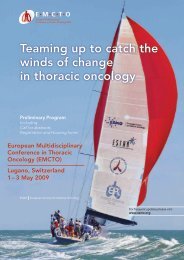Bladder cancer - European Society for Medical Oncology
Bladder cancer - European Society for Medical Oncology
Bladder cancer - European Society for Medical Oncology
You also want an ePaper? Increase the reach of your titles
YUMPU automatically turns print PDFs into web optimized ePapers that Google loves.
WHAT ARE THE TREATMENT OPTIONS?<br />
Planning of the treatment involves a team of professionals from different medical<br />
disciplines. It usually implies a meeting of the different specialists, called<br />
multidisciplinary meeting* or tumor board review*. In this meeting, the<br />
treatment planning will be discussed according to the relevant in<strong>for</strong>mation<br />
mentioned above.<br />
The treatment will usually combine therapies that<br />
• Act on the <strong>cancer</strong> locally, such as surgery, radiotherapy*, local chemotherapy* and local<br />
immunotherapy*<br />
• Act on the <strong>cancer</strong> cells all over the body using systemic chemotherapy<br />
The exact treatment will depend on the stage of the <strong>cancer</strong>, on the characteristics of the tumor and<br />
on the risks <strong>for</strong> the patient.<br />
The treatments listed below have their benefits, their risks and their contraindications*. It is<br />
recommended that patients ask their doctors about the expected benefits and risks of every<br />
treatment in order to be in<strong>for</strong>med about the consequences of the treatment. For some treatments,<br />
several possibilities are available. The choice should be discussed according to the balance between<br />
benefits and risks.<br />
Treatment plan <strong>for</strong> non‐muscle invasive disease (stage 0a, stage 0is, stage I)<br />
At these stages, the tumor is confined to the superficial layer of the bladder wall (mucosa*) and does<br />
not invade the muscle of the bladder. The main goal of the treatment is to remove the local tumor by<br />
surgery during a TURB*. However, additional treatment delivered locally in the bladder (called<br />
adjuvant* intravesical* treatment) is recommended since it lowers the risk that the tumor recurs or<br />
progresses.<br />
The type of adjuvant therapy depends on the risk of progression* and recurrence*: <strong>for</strong> each patient<br />
with a stage 0a or stage I tumor, this is calculated using a scoring system based on several tumor‐<br />
specific characteristics.<br />
Cystoscopy* and transurethral resection of the bladder tumor (TURB)*<br />
After an initial cystoscopy all patients undergo a TURB. Often, the complete tumor is resected,<br />
and the TURB in this case is the definitive treatment. However, sometimes, it is recommended to<br />
give additional treatment (called adjuvant treatment*) with drugs that are applied directly into<br />
the bladder (called intravesical* treatment). The type of additional treatment depends on the<br />
individual risk of recurrence and progression*, but also the patient’s capability to tolerate side<br />
effects*.<br />
In selected patients with high risk tumors, a second TURB is recommended either be<strong>for</strong>e or after<br />
intravesical therapy, to help detect residual disease and to provide a more accurate staging.<br />
<strong>Bladder</strong> <strong>cancer</strong>: a guide <strong>for</strong> patients‐ In<strong>for</strong>mation based on ESMO Clinical Practice Guidelines ‐v.2012.1 Page 12<br />
This document is provided by Reliable Cancer Therapies with the permission of ESMO.<br />
The in<strong>for</strong>mation in this document does not replace a medical consultation. It is <strong>for</strong> personal use only and cannot be modified,<br />
reproduced or disseminated in any way without written permission from ESMO and Reliable Cancer Therapies.
















